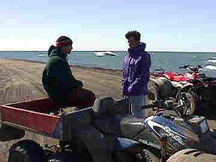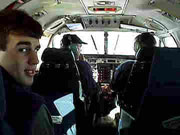Students in Arctic Research (STAR) | Aaron Stupple
Stamford, New York
Project: Archeological Excavation in Deering, Alaska
Principal Investigator: Dr. Glenn Sheehan, Ukpeagvik Iñupiat Corporation, Barrow, Alaska
TEA Teacher: Tim Conner, Binghamton, New York
 Follow-up Visit
Follow-up Visit
Aaron and Tim returned to Barrow 2-8 April 1999 to continue their work with Dr. Sheehan and his associates. See their new journals and photos.
Biography
During Aaron's long affiliation with the Boy Scouts of America, he earned the prominent distinction of Eagle Scout, along with 27 merit badges, including one for environmental science. That experience, along with extensive backpacking and winter camping experience prepared him for the hard work, different cultures, and un-modern facilities that he encountered while in rural Alaska. Aaron grew up in the small town of Stamford, New York, in the Adirondacks, graduating salutatorian of the Stamford High School's 1998 graduating class, concentrating his coursework in math and science. Aaron pitched for the baseball team and participated in soccer, skiing, yearbook, Students Against Drunk Driving (SADD) and was secretary of the National Honor Society. He acted, sang and even juggled in several school theatrical productions, including Fiddler on the Roof, Music Man, Once up on a Mattress, and Into the Woods. Another artistic interest of Aaron's is sculpting in clay, wood and metal. For the last two years Aaron has been a Volunteer Youth Role Model, spending time weekly with one local boy. The Cornell Environmental Sciences Interns Program (Young Scholars Program) selected Aaron to participate in a summer research project on the effects of earthworm invasion on soil properties in the temperate forest. Aaron earned several competitive scholarships that he is taking to Cornell University in the fall of 1998 to continue his education at in biology and pre-medicine.
Life in Deering
By Aaron Stupple
 My time with the Teachers Experiencing the Arctic 1998 has been without question the most exciting three weeks of my life. To describe why this is so would require more paper than an environmentally conscious person could stomach. There were a great many experiences and moments, all of which I will remember and retell over and over again. These include flying across the country after never having flown before or traveled west of Georgia (this alone was worth the price of admission, which was taken care of entirely by the National Science Foundation), meeting all the members of the Arctic Research Consortium of the United States and my great companion (and prescribed teacher), Tim Conner, flying up to the northernmost point of the U.S., experiencing the midnight sun, meeting more people directly affiliated with state-of-the-art research projects, village hopping down Alaska's North Slope, arriving in Deering and meeting all the archeologists and villagers, being thrust into world class archeology and excavating museum quality artifacts, being introduced to the honey bucket phenomenon (a five gallon substitute for flushing toilets), taking a four-wheeler ride to an abandoned gold mining town, swimming in Arctic waters, and seeing Greenpeace in person. To sum it all up, I had a truly fantastic time in Central, Northern, and Western Alaska.
My time with the Teachers Experiencing the Arctic 1998 has been without question the most exciting three weeks of my life. To describe why this is so would require more paper than an environmentally conscious person could stomach. There were a great many experiences and moments, all of which I will remember and retell over and over again. These include flying across the country after never having flown before or traveled west of Georgia (this alone was worth the price of admission, which was taken care of entirely by the National Science Foundation), meeting all the members of the Arctic Research Consortium of the United States and my great companion (and prescribed teacher), Tim Conner, flying up to the northernmost point of the U.S., experiencing the midnight sun, meeting more people directly affiliated with state-of-the-art research projects, village hopping down Alaska's North Slope, arriving in Deering and meeting all the archeologists and villagers, being thrust into world class archeology and excavating museum quality artifacts, being introduced to the honey bucket phenomenon (a five gallon substitute for flushing toilets), taking a four-wheeler ride to an abandoned gold mining town, swimming in Arctic waters, and seeing Greenpeace in person. To sum it all up, I had a truly fantastic time in Central, Northern, and Western Alaska.
The most striking aspect of the trip was twofold. Not only did I partake in incredible archeology, but I met a great number of wonderful people along the way, especially in Deering where the research project was.
 Deering is a village faced with difficult problems just like many towns across the country, but its issues are not as common. They are comprised of obligations to the past, problems of the present, and hopes for the future. Deering has no running water. People use honey buckets&emdash;five-gallon pails with plastic bags&emdash;instead. This unsanitary system has led to disease and other problems. The village needs a sewage line, but while one was being dug, incredible artifacts were discovered. This halted the project entirely until some decision could be reached as to proceed. A group of archeologists, led by Glenn Sheehan, were required to investigate and excavate the area where the sewage line would lie. This significantly lengthens the time before the line will be installed. There are many different opinions on how this problem should be solved. The local elders think the artifacts should be removed, but should stay in the town for the villagers to see. They also think that everything else should be reinterred.
Deering is a village faced with difficult problems just like many towns across the country, but its issues are not as common. They are comprised of obligations to the past, problems of the present, and hopes for the future. Deering has no running water. People use honey buckets&emdash;five-gallon pails with plastic bags&emdash;instead. This unsanitary system has led to disease and other problems. The village needs a sewage line, but while one was being dug, incredible artifacts were discovered. This halted the project entirely until some decision could be reached as to proceed. A group of archeologists, led by Glenn Sheehan, were required to investigate and excavate the area where the sewage line would lie. This significantly lengthens the time before the line will be installed. There are many different opinions on how this problem should be solved. The local elders think the artifacts should be removed, but should stay in the town for the villagers to see. They also think that everything else should be reinterred. The archeologists feel that the artifacts should certainly be removed and properly stored, ideally in a local museum. The Village Safe Water construction crew isn't too concerned with archeology, they want to install the line now. The villagers themselves are torn between having flushing toilets soon on one hand, or waiting longerand saving artifacts that are an important piece of Alaska's prehistoric cultural puzzle. Tim Conner and I were thrust right in the middle.
We thoroughly enjoyed being able to excavate artifacts in a site so laden with significant material that many archeologists spend their lives without ever seeing anything like it. We spent the entire time with professional archeologists, digging and conversing with them as if we too had Masters and Ph.D.s. All the while I expected National Geographic to walk up and start a special on the finds here. The idea is not at all far-fetched. I feel truly privileged to have been given this opportunity, and I am very grateful to the National Science Foundation for providing me with it.
The best part was that we spent the whole time digging along with five Native Inupiat Eskimo people from Deering. We would talk with them all day, and afterward they took us on tours of the interior, fishing trips, and even swimming. It was great experiencing their way of life for two weeks. When talking about traveling to Alaska, everybody raves about Denali Park, the coastline, and Glacier Bay. No one ever hears about a larger aspect that is very much Alaska, the Native people. The experience of living with them was as eye-opening as the artifacts which were excavated along the way.
Despite all the different pressures on the village, Deering is a town that seems to know how to pull together. Families felt responsible for other families, parents took care of other parents' children, creating a general feeling of togetherness that Tim Conner and I felt a part of. We could have easily been dismissed as self involved New Yorkers there on a lark, and it would have been hard to blame them if they felt that way. But they didn't at all. They took Tim Conner and I at face value, a difficult thing for anyone to do, and before long we were talking and laughing together in the pit as if we were hometown buddies. If not for their gracious hospitality, our trip would have lacked a serious element.
Out of all the people who visit Alaska, almost no one gets to live life Deering style. I am really going to miss everyone, and I would like to thank them for treating us so well.

